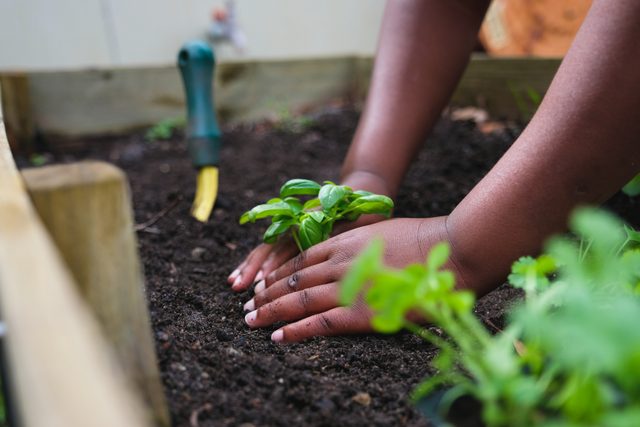How To Grow Basil
Did you know basil is considered the king of herbs? In Greek, the word basilikos means “royal,” and basil was once used only in royal ceremonies.
In my garden, I can hardly wait for spring weather to settle down so that I can transplant the basil I started from seed. I grow four types of basil because it’s my favorite herb to top homemade pizza and salads.
Types of Basil
There are many types you can grow in your garden.
Sweet basil
When you imagine basil’s heady aroma, you’re probably thinking of sweet basil varieties like ‘Genovese’ and ‘Large Leaf.’
Miniature basil
Basils also come in smaller varieties like ‘Boxwood,’ ‘Minette’ and ‘Spicy Bush.’ Maxing out at 10 to 12 inches, these are great for small containers.
Scented basil
Scented basil leaves smell and taste like cinnamon, lime, lemon, or anise, AKA Thai basil. The latter is native to Southeast Asia and popular in Asian dishes. It has dark stems, purple flowers and a slight licorice taste.
Holy basil
Holy basil’s clove-scented leaves are used in religious ceremonies and as a medicinal tea. It’s also a beautiful plant beloved by bees.
How To Plant Basil

When to plant basil
Plant basil outside after your last average frost date, once the soil warms to 65 F to 70 F. Like most vegetables and herbs, basil needs six to eight hours of sun per day. Prevent diseases by spacing plants far enough apart for good air circulation and rotating where you grow it from year to year.
Want basil fast? Plant transplants
- Buy transplants at your local nursery or big box store.
- Dig a hole slightly larger than the transplant pot in good, well-drained, neutral to slightly acidic soil.
- Add a handful or two of compost to the hole, working into the soil around.
- Plant the transplant.
- Once the basil is planted, spread compost around the planting area as mulch and then water. You can buy compost like organic Happy Frog Soil Conditioner or make your own compost ahead of time.
Not in a hurry? Start seeds indoors
If you want to grow unique basil varieties, you can start seeds indoors.
Or, plant basil seeds directly outside
Alternatively, you can plant seeds directly outside.
- Sprinkle seeds on well-drained soil and lightly cover.
- Keep watering seeds daily until they sprout and grow.
How To Grow and Care for Basil
If you planted seeds outdoors, when basil seedlings have their second set of leaves, thin them to two inches apart.
Water as needed
To develop strong, deep roots, water basil about an inch once a week. Drip irrigation or soaker hoses water deeply and consistently. If it rains, you can skip watering.
Fertilizer
Fertilize plants about mid-season if the plant looks faded and stressed, but don’t overdo it. Rapid growth from nitrogen attracts insects and may change the flavor of the leaves.
Insect pests
These are the four most common insects that attack basil.
- Japanese beetles: Hand pick and drop into soapy water.
- Aphids and spider mites: Use a strong spray of water or insecticidal soap.
- Slugs: Don’t mulch heavily around plants. If slugs are a huge problem, apply diatomaceous earth or slug bait with iron phosphate.
Diseases
Basil can be affected by a variety of diseases, including wilts and mildews.
- Fusarium wilt: Plants grow normally until six to 12 inches tall, then leaves suddenly wilt and turn black. Throw infected plants in the trash. Do not compost.
- Gray mold: Infection starts in the cut areas. To prevent this, don’t water overhead until 48 hours after harvesting, and don’t harvest on rainy days.
- Leaf spots: Black spots appear on leaves. Pull off and discard leaves at the first sign of disease. If spotting continues, spray weekly with a natural fungicide like Bonide fungal disease control.
- Downy mildew: This causes yellowing of leaves and small dark dead spots. Remove and dispose of affected plants in the trash. Plant downy-mildew resistant varieties like ‘Prospera,’ ‘Rutgers,’ ‘Devotion’ and ‘Rutgers Obsession.’
Grow basil in containers
If you don’t have a garden, you can grow basil in containers, such as flexible fabric grow bags or planting beds. You can grow most vegetables and herbs in containers. Pro tip: Grow tomatoes and basil together for an easy harvest.
How To Harvest Basil
- Wait until plants are six inches tall.
- Harvest individual leaves or cut back stems for a larger amount.
- For a large harvest, don’t cut the plant back more than one-third.
Pruning basil
Pruning basil is easy, but don’t crush stems as you clip them. Trimming stems slows flower production and makes the plant bushier.
After harvest
Treat basil and other herbs like flowers and store them at room temperature. Place stems in a glass or vase of water. Pull off any leaves underwater that could become slimy. Stored as a cut flower, basil will last five to 10 days. Or you can cut it right before you’re going to eat it.
Too much bounty?
If you have a large summer harvest, make pesto, or chop and freeze basil in ice cubes for that fresh taste all year long. Here are other ways to preserve your garden goodies.
No comments